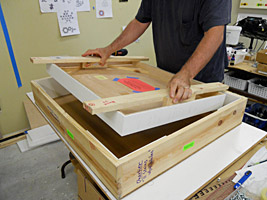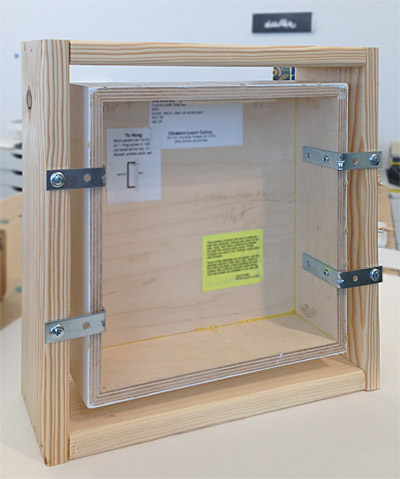All acrylic paintings tend to stick to wrapping materials, so it’s important that nothing touch the surface for very long. My paintings also involve the use of materials that may gradually change as they continue to interact and respond to each other, to light condition, and to the passage of time. These changes are part of my Testing exploration and process.
PLEASE SAVE THE WOODEN CRADLE OR BOX – it’s the only safe way to handle my work.
My work leaves my studio floated inside a wooden cradle that was made for that painting, to insure that the surface doesn’t touch anything. The surface is an acrylic resin which remains slightly sticky & pliable like a gummy bear, and it’s easily damaged. After years of trying every other wrapping method, I’ve found the cradle to be the only safe way to transport & store my work. My galleries should deliver each painting in it’s cradle. If not, ask for it—it is part of the work. (Very small paintings may have a storage box instead. Please read any notes on the box before storing long-term.)
To clean the surface:
• Begin cleaning a dusty or dirty painting by gently dusting with a soft microfiber cloth, “swiffer duster” or a tack cloth.
• Before cleaning the face of the painting any further, look on the back of the work to see if it has a neon green “ATUM” sticker near my signature. If it does, this means I used “Acrylic Topcoat Ultra Matte” as the final coating, and it could be damaged by liquids—so there’s no further cleaning you can do without risking damage.
• If there’s no green ATUM sticker on the back, the piece has a topcoat of a professional varnish, which won’t be affected by water. All of my larger paintings (30 x 40″ or larger) are varnished. You can try gently washing it with just water and a soft cloth, or add a bit of Dawn or other detergent, (be sure to give it a final wash with no soap). Saliva is also well worth trying, as it has enzymes that can lift many stubborn marks. Avoid buffing the face of the painting with excessive rubbing or pressure, as this can change the sheen of the varnish in that spot.
• One the sides of the painting (not the face), you can also try a “magic eraser” or isopropyl alcohol diluted 50/50 with water. These products can change the sheen, so don’t use them on the face of the painting, only on the sides—and only if there’s no ATUM sticker on the back.

Light: strong light can affect the painting, causing some of my inks, dyes and stains to shift in color over time. Although the idea of change is integral to the work and should be expected as part of the Testing process, it’s best to protect the work from constant direct sunlight unless the piece is part of an ongoing SunTest exposure study.
Yellowing: some paintings have an off-white, “vanilla” or mild yellow background tone, with variations depending on the thickness of the resin, which spray paints I used, etc. The yellow quality can intensify if the painting has been stored in the dark for awhile. You can lighten the yellow tone by exposure the painting to sunlight in a window for a few days to a week or so, depending on the time of year and how strong the light is.


Shipping & Storage:
Always store and transport the painting in it’s wooden cradle if you have it.
Don’t wrap the painting in anything—no plastic, or glassine, or paper, or bubble wrap or any other material should touch the face of the painting.
If you no longer have the cradle you can temporarily use a clean, flat, smooth piece of acid free foam core as a facing board before wrapping in other materials. Please don’t let anything else touch the surface—I have not found any other material to be reliable. Acid free foam core is less likely to stick to the surface than regular foam core or other board, but only for a short time. Cut the foam core slightly larger than the painting. Be sure to dust off any grit or debris from the board, and from the surface of the painting. Place the facing board against the painting, then lightly wrap the package in bubble wrap or other packing material. Don’t put any pressure on the surface of the painting, otherwise the board might stick to it. For longer term storage the painting must be floated so the surface doesn’t touch anything. I’m happy to provide a drawing of how to build a simple cradle, just get in touch.
Repairs: If the surface is damaged I can sometimes repair the painting. The price for such repairs depends on the size & extent of the damage. Contact me or my gallery for details.